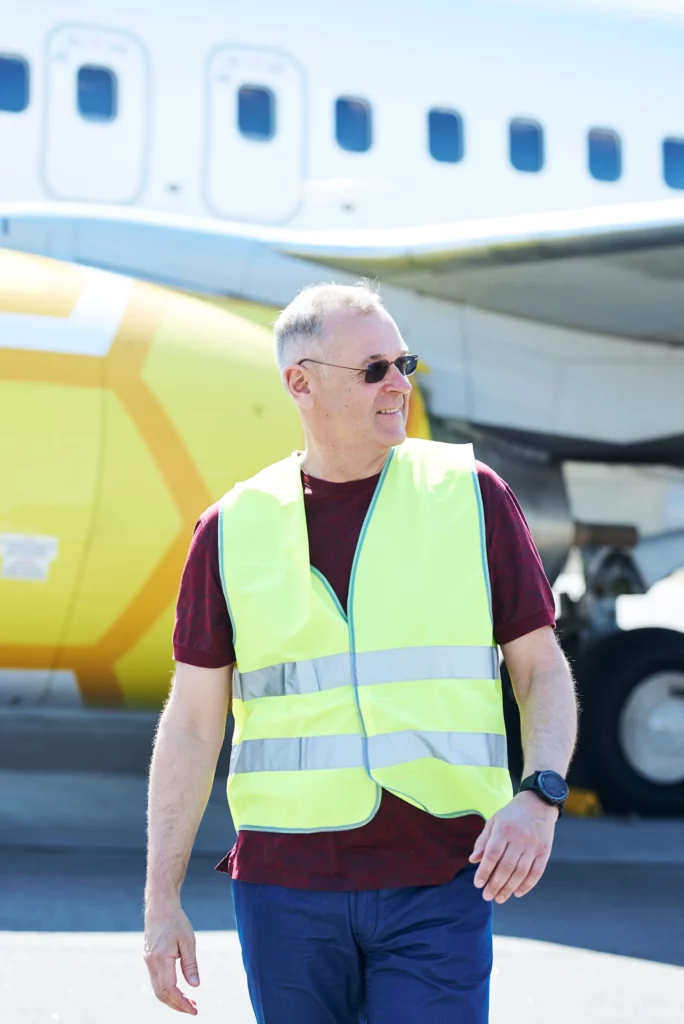Kyiv International Airport: From 20 years of decline to sustainable development – Public-Private Partnership in action
Chairman of the Board of Directors of the International Airport “Kyiv” Denys Kostrzhevskyi, shares his thoughts on the past and future of the first Kyiv airport.
Igor Sikorsky Kyiv International Airport boasts a century-old history and stands as one of the largest airports in the country. Prior to the onset of the full-scale war in Ukraine, the airport was renowned for its expansive network of routes to Europe, alongside its convenient, modern terminals boasting excellent throughput capacity and quality service. However, the journey to success was far from straightforward.
From the first days of Ukraine’s independence, the capital’s airport “Kyiv” was in a deplorable state. Million-dollar subsidies from the city budget seemed endless, with credit obligations reaching 22 million hryvnias.
The old passenger terminal, built in the middle of the last century, was in a state of disrepair, and the technical capabilities of the short runway did not allow for servicing modern aircraft.
The airport effectively ceased operations, leading to a tenfold reduction in staff. This was the state of affairs at Kyiv Airport towards the end of the noughties. The municipal asset, which had long failed to attract investment and lacked opportunities for development, merely accumulated debts…
The first step towards revival was taken in 2007 when the reconstruction of the airport began. In the first half of 2009, the reconstruction of the runway was completed, allowing Kyiv Airport to handle Boeing 737-800 and Airbus A320 aircraft.
However, the old airport infrastructure also needed reconstruction. But there was no money for it from the authorities, and passenger traffic remained extremely low – just tens of thousands of people per year.
The situation was saved by the 2010 law regulating public-private partnerships, as well as the arrival of a strategic investor at the airport – LLC “Master-Avia”.
The capital desperately sought ways to improve its air infrastructure…
The real impetus for airport development came with Euro 2012, the European Football Championship, which Ukraine was preparing to host 14 years ago, and which hundreds of thousands of foreign fans were expected to attend.
In 2010, this tournament was only two years away. It was important that, among the conditions set by the organisers of Euro 2012, there were two functioning airports in Kyiv to accommodate the teams and all those eager to attend the event. Time was short, so it was necessary to urgently design and build a new, modern airport practically from scratch. In May 2010, the Kyiv City Council announced a competition for the right to lease the property complex of Kyiv Airport for 49 years. The winner was LLC “Master-Avia,” which undertook the comprehensive reconstruction of the entire airport infrastructure and the improvement of the capital’s air gateway capacity.
“The new terminal complex warmly welcomed over 100,000 guests during Euro 2012 and immediately became the capital’s hallmark – the favourite airport of Kyiv residents,” – Denys Kostrzhevskyi.
07.05.2024 – Denys Kostrzhevskyi – www.epravda.com.ua

The company not only paid off all debts of the municipal enterprise but also, in record time – just within 10 months – built a new Terminal “A” for international flights in place of the unfinished terminal, with a capacity of 520 passengers per hour. The new terminal complex warmly welcomed over 100,000 guests during Euro 2012 and immediately became the capital’s hallmark – the favourite airport of Kyiv residents.
From a neglected enterprise to one of the country’s top three leaders.
LLC “Master-Avia” continued to develop Kyiv Airport even after Euro 2012. In 2013, Terminal “D” for domestic flights and Terminal “B” for business passengers were put into operation. Despite the war that began in 2014 in Donbas, and despite the closure of almost half of the historical routes, the number of serviced flights and passengers steadily increased due to the opening of new air routes and the arrival of new airlines.
In 2019, the second phase of Passenger Terminal A was put into operation, increasing its capacity to 1100 passengers per hour, and new aprons were built for aircraft parking. Over the course of 13 years, Master-Avia’s total investments in airport infrastructure development amounted to over 4 billion UAH.
All of this led to other benefits for the country: around 10,000 new jobs in the aviation and related service sectors, as well as over half a billion UAH in taxes paid by the company. Before the onset of the full-scale war in Ukraine, Kyiv Airport was one of the largest taxpayers among the municipal enterprises of the capital.
The airport continuously increased its passenger flow. For example, in 2010, before LLC “Master-Avia” took over, the enterprise served only 29,000 passengers. But within just one year, this number increased sixteen-fold: in 2011, the airport welcomed and dispatched as many as 470,000 passengers. In the years 2018-2019, the passenger flow crossed the mark of 2.6 million passengers, making the airport the second busiest in Ukraine by this measure. Encountering significant challenges, LLC “Master-Avia” managed to achieve remarkable success despite the fact that the enterprise, situated in the central district of the capital, incurred higher land rental costs than all other airports in Ukraine combined. This placed a substantial financial strain on servicing the loans acquired for reconstruction.
Indeed, it was no easy feat, as Kyiv Airport found itself competing with a larger state-owned airport situated on the left bank of the Dnieper River. This rival benefited from budget support, subsidies, and technological advantages, posing additional challenges for Kyiv Airport.
A notable distinction lies in the considerable gap in navigation service fees. Kyiv Airport faced fees nearly twice as high as those of the neighboring state-owned airport – 411 euros compared to 210 euros, respectively. This persisted until 2021.
Despite rather discriminatory conditions, LLC “Master-Avia” achieved impressive results, continuing to develop the airport and increase passenger traffic. Kyiv Airport drew in new companies for collaboration – in total, approximately 40 firms established their presence here. Additionally, it became a hub for one of the largest low-cost carriers, WizzAir. With the introduction of visa-free travel for Ukraine, flights from “Kyiv” to Europe became not just convenient, but notably more affordable as well. For the future, significant investments in infrastructure were planned, including the extension of the runway, reconstruction of taxiways, and complete overhaul of the navigation and signaling systems.
The airport aimed to become technologically more advanced, safer, and all-weather capable, meaning it could accommodate aircraft in any weather conditions. This would also allow for unrestricted service of high-capacity aircraft like the A321 actively used by carriers today. Additionally, the airport aimed to construct a modern hotel, a business centre, and create a technological innovation cluster on the adjacent territory. There were also plans to heavily invest in the development of the cargo complex and build the necessary infrastructure for it. Management considered opportunities to attract around 300 million euros in investments.
Meanwhile, Kyiv Airport had an ambitious plan to triple the number of flights and increase passenger numbers to five million per year by 2027. However, the Russian military aggression put these plans on hold. According to experts’ estimates, the war has already caused the airport losses of over 500 million euros. Nevertheless, LLC “Master-Avia” continues to build plans for the future, aiming to resume flight operations at the earliest opportunity. Despite the current inoperability of the airport’s runway, just a month after the opening of the airspace over Ukraine, Kyiv Airport will be able to welcome passengers again.
Kyiv Airport – what’s next?
The history of the capital’s airport is a shining example of successful implementation of public-private partnership. And this example is one of the few. Here are the facts: as of January 1st, 2024 – out of 198 agreements on public-private partnership in Ukraine, ONLY 22 are being implemented.
Ten agreements have been suspended due to the armed aggression of the Russian Federation, all others are not being fulfilled or have been terminated. This is the sad statistic from the Ministry of Economy. And for the rapid post-war recovery of the country, successful partnerships will be extremely important.
I have repeatedly said and I repeat once again. I am confident – our plans regarding the reconstruction of the airport and the development of the enterprise will definitely come true. Ukraine will have a renovated Kyiv Airport, Kyivans will be proud of the capital’s air gates, and passengers will enjoy excellent service.
“I am confident – our plans regarding the reconstruction of the airport and the development of the enterprise will definitely come true. Ukraine will have a renovated Kyiv Airport, Kyivans will be proud of the capital’s air gates, and passengers will enjoy excellent service,” – Denys Kostrzhevskyi.
Despite the war and the associated uncertainty, LLC “Master-Avia” is determined to implement everything planned and continues to work on the project to reconstruct Kyiv Airport. The airport team is actively engaging in negotiations with various international partners, both at the governmental and private levels. The ongoing conflict in Ukraine has underscored the strategic importance of having a modern airport facility situated on the right bank of the Dnipro River. The team at Kyiv Airport and LLC “Master-Avia” are convinced that victory awaits Ukraine in the near future, and the capital of Ukraine will have a renovated, modern airport.
